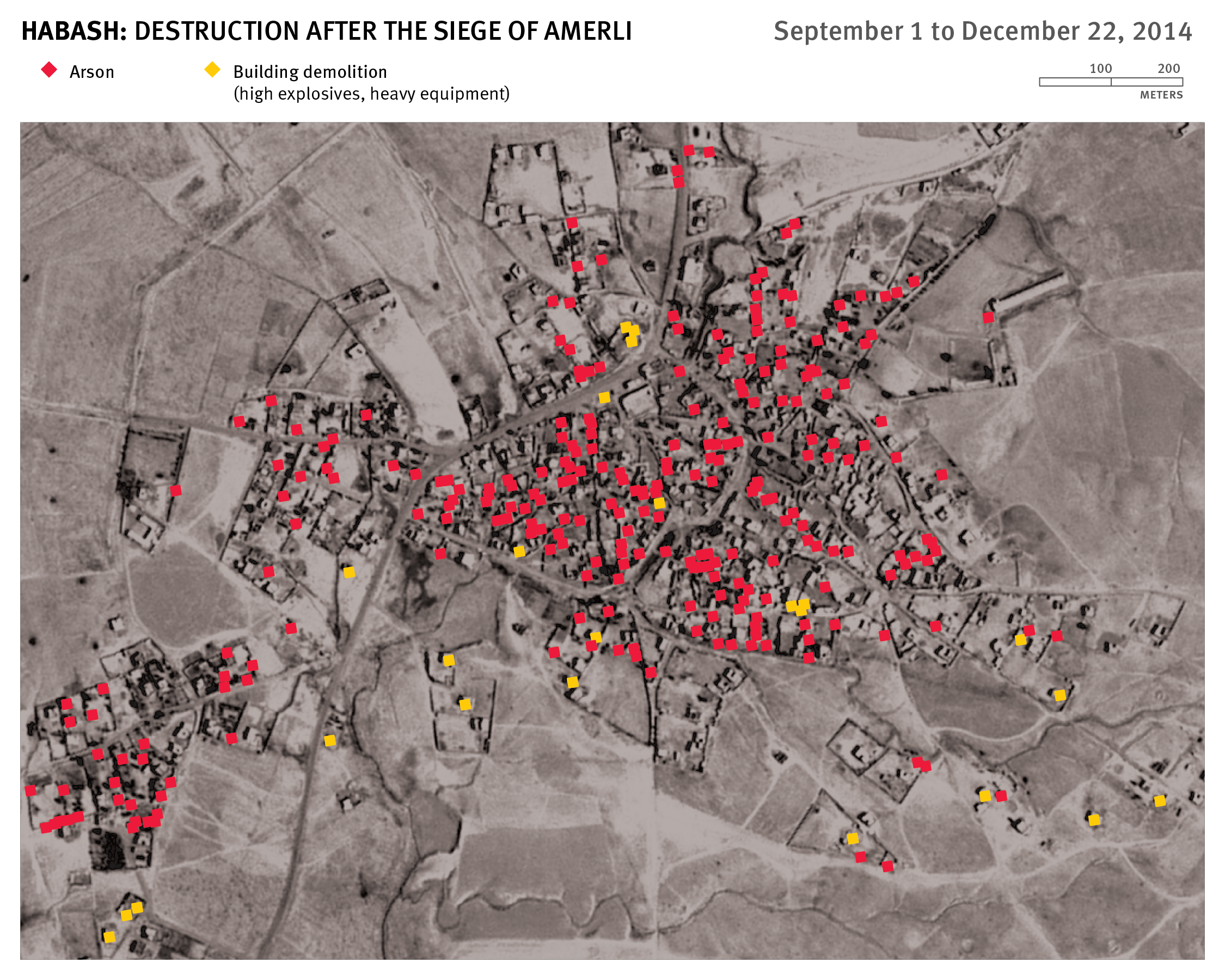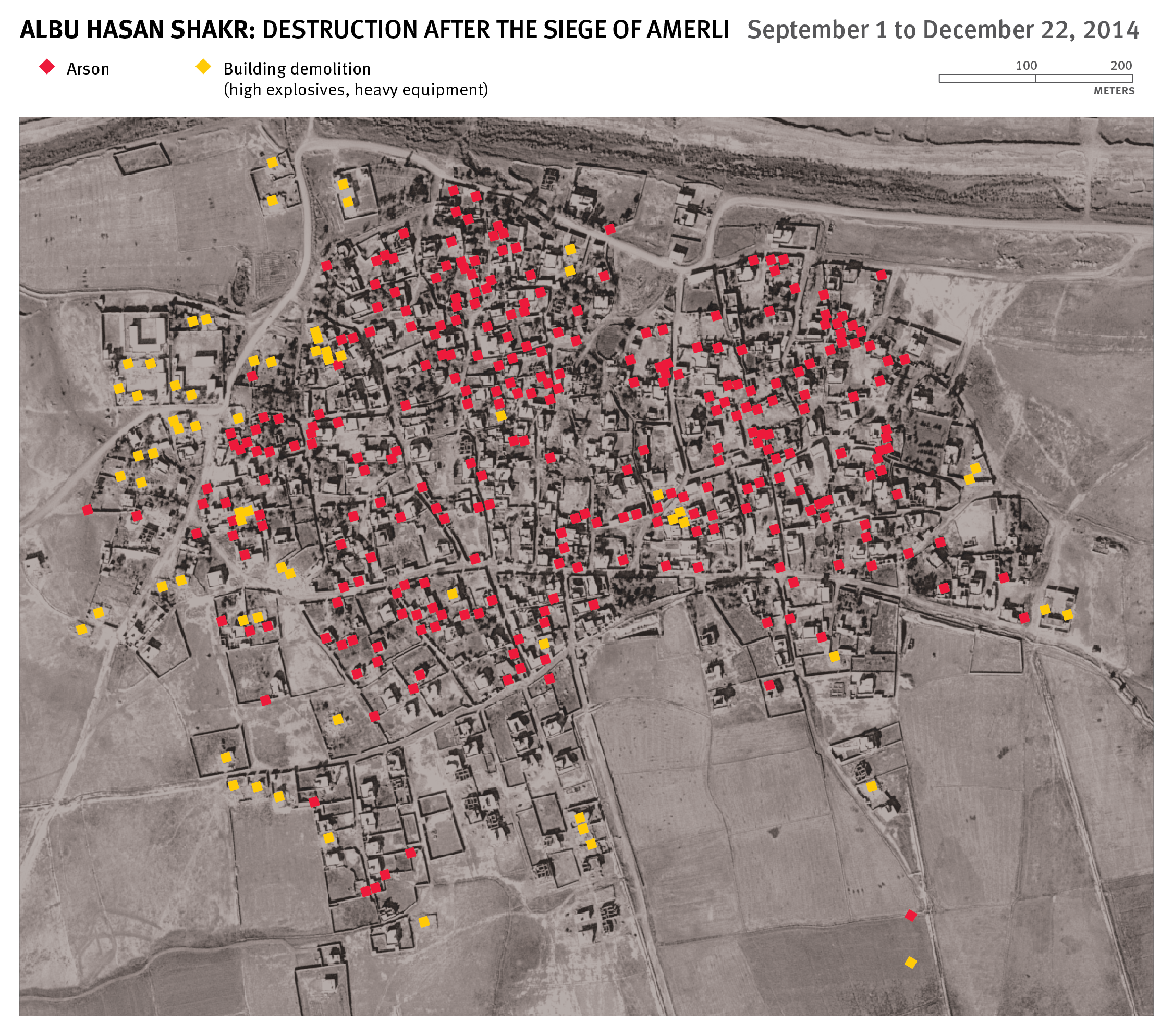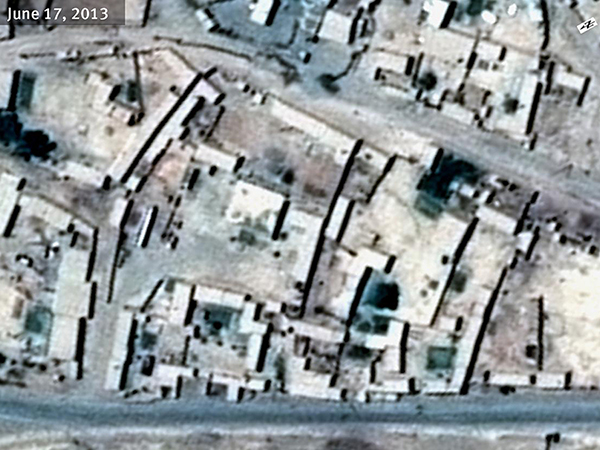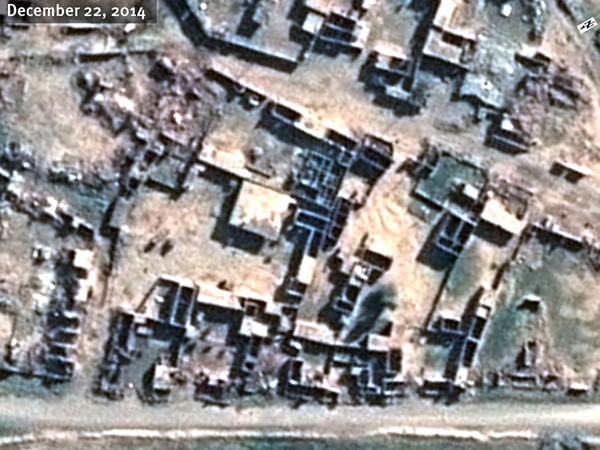Burning of Civilian Property
Human Rights Watch found widespread burning of residential homes and businesses in villages in Salah al-Din province that Shia militia groups, including Asa’ib Ahl al-Haqq, the Badr Brigades, Saraya Tala’a al-Khorasani, and Kita’ib Hezbollah, as well as some members of the Iraqi security forces, occupied during and after the campaign to lift the siege of Amerli. On August 30, 2014 air strikes, including at least four carried out by the US, struck ISIS targets surrounding Amerli and paved the way for Iraqi ground forces, including the militias, to retake Amerli, after which they went on to occupy surrounding villages.[12] After occupying villages militia members caused large- scale damage and displacement, witnesses and security forces told Human Rights Watch.
Human Rights Watch identified in satellite imagery evidence of widespread building destruction in 30 of 34 villages in the area surrounding Amerli. Human Rights Watch identified at least 2,600 buildings likely destroyed by fire. The satellite imagery showed that building fires started during the first two weeks of September in 25 villages, and expanded during the second half of September to affect a total of 30 villages.
Although a large majority of fire-related building destruction occurred in September, there is strong evidence in the satellite imagery that building fires continued in at least 11 towns and villages though the months of October, November and possibly December, resulting in the further destruction of at least 600 buildings.[13]

The widespread burning of civilian homes by the militia groups in areas under their control appeared to have had no clear military objective and to represent collective punishment against residents of local Sunni villages.
Residents from 16 different villages in an approximate 20 kilometer radius of Amerli told Human Rights Watch of incidents of arson by members of militias who targeted civilian homes and shops and, in two villages, a mosque and school. A high-ranking Peshmerga commander closely involved in the Amerli operation told Human Rights Watch that in the mainly militia-led operations, militia and Iraqi ground forces targeted 47 villages.[14]

Another Peshmerga commander who was involved in joint operations against ISIS in the Suleiman Bek sub-district said he witnessed militias using kerosene to torch homes in the villages of Khazer Darli, Suleiman Bek and Yengija. He described the operation as being poorly coordinated between the different forces, but said that militia commanders were present during the arson operations. Peshmerga officers at the scene said they heard no official orders to set fire to buildings, but also said that militia commanders at the scene did nothing to stop the burning.[15]
Human Rights Watch researchers visited the towns of Yengija, al-Salaam, Tuz Khurmato and Khazer Darli on October 17 and 18, 2014 and saw ongoing fires and the burned out remains of homes. Satellite imagery of al-Salaam taken on September 14 shows evidence of large-scale fire damages to at least 25 buildings two weeks after ISIS forces left the areas around Amerli. Satellite imagery recorded on September 17, 28 and November 6, shows at least 25 additional buildings were destroyed, indicating that the arson observed on September 14 was followed by fires later in September and possibly October.[16] In addition to fire damage, Human Rights Watch identified evidence in satellite imagery of the systematic demolition of over 125 buildings in al-Salaam after September 14, consistent with the use of heavy explosives and earth-moving equipment.[17] Human Rights Watch researchers visited the village and saw rows of houses and businesses destroyed by fire, houses which had clearly been looted, with personal belongings and furniture strewn outside and doors and gates kicked in. Human Rights Watch researchers also saw rows of houses that had been destroyed, including multi-story houses that had collapsed in to piles of rubble with their concrete roofs resting on top, consistent with the use of heavy explosives. Satellite imagery later confirmed that the destruction took place after militias had taken control of the area in mid-September, 2014.
Researchers also saw that on the exterior walls of many of the houses in Khazer Darli and Yengija, Saraya Tala’a al-Khorasani and Asa’ib Ahl al-Haqq militias spray painted the names of their group, as well as anti-Sunni and pro-Shia slogans.
The militia Saraya Tala’a al-Khorasani appeared to control 95 per cent of the town of Yengija when Human Rights Watch visited on October 17. Human Rights Watch documented the destruction of 18 homes and shops side by side in a 400 meter stretch of road in the town, all of which appeared to have been deliberately set ablaze. Black soot marked the windows where flames had engulfed the interior and charred the outer walls. Homes of poorer residents, commonly made of handmade mud bricks, had crumbled in the heat of the blaze, whereas sturdier multi-level brick homes and shops showed clear signs of smoke and fire damage but remained standing. While the structure of those buildings remained intact, the interior of one or several rooms were charred and its contents destroyed. Researchers visited one home where the traces of petrol were still present after a fire, providing physical evidence of the use of a fire accelerant. Human Rights Watch spoke to witnesses who saw militias actively using accelerants such as petrol in arson attacks.
Yengija resident A.M. described the destruction he saw when he snuck into the town to gather belongings from his home earlier that month:
We can distinguish the militias because they advertise themselves—their cars bear their logo, they fly their flags at checkpoints and wear insignia on their uniforms. I heard from people who stayed in the village that [militiamen] were burning down houses, looting and blowing up houses…. I went back last week, approximately 10 days ago, because our financial situation is poor and I needed to collect our belongings, especially as winter is coming. When I got there I saw that 99 percent of the houses in my neighborhood were burnt down and nothing was left…. While I was there we saw smoke rising from three different places. The smoke was coming from the areas in front of my house, near the main road near the militia offices…. The school was burnt down too, and they burnt three clinics and four mosques.[18]
Human Rights Watch analyzed satellite imagery recorded over Yengija and found evidence of a widespread and sustained campaign of arson and demolition that lasted over two months after the end of the siege of Amerli, corroborating witness accounts.
Human Rights Watch identified a total of 415 destroyed buildings in Yengija, 375 likely destroyed by fire and a further 40 likely demolished with high explosives and earth-moving equipment. An examination of building destruction in satellite imagery over time shows during the first two weeks of September at least 50 buildings were destroyed by fire. Between September 14 and November 6 building fires in Yengija increased sharply, destroying an additional 290 buildings. The satellite imagery shows further evidence of at least 35 buildings destroyed by fire in Yengija between November 6 and December 22, 2014.

K.A., from the town of Laqum, 17 kilometers from Amerli, described to Human Rights Watch how, as militias moved through surrounding villages, he saw smoke rising from the houses that were being set ablaze. He told Human Rights Watch that the militias moved systematically from the village of Hufriyya Kabira to Hufriyya Saghira, Albu Ghenam, and Liysasat, two kilometers from his village. He told Human Rights Watch that he saw “intense” clouds of smoke rising as militias cleared the villages around Amerli, and that the burning continued for over a week through this group of villages.[19]
Arson in Hufriyya


Satellite imagery recorded over the villages of Hufriyya, Habash, and Laqum revealed evidence of widespread fire-related destruction of over 620 buildings. A majority of building fires in these villages occurred throughout September with evidence in the satellite imagery that fires likely continued into October and possibly November.
G.H., a witness from Tal Sharaf village, 30 kilometers south of Amerli, described watching the homes burning in villages under militia control two weeks after the Amerli offensive ended. He told Human Rights Watch:
All villages were attacked [by militias]. I left my village on September 20. At that time, the army and the Hashd al-Shaabi controlled the Suleiman Bek sub-district, and Amerli had been liberated. I left at 7 p.m. with my family and all the other families from the village, we only had the clothes we were wearing and our IDs. We didn’t take anything with us. When we left, the Hashd al-Shaabi had not yet entered our village, but we saw smoke coming from all the other [nearby] villages. I was still in [Tal Sharaf] when I saw the others burning. There was an influx of people coming to our village from Suleiman Bek, Habash, Ghamaz, Maftoul and Saha. They all came to our village from their homes and then went [to seek safety] in Sharaf Kabir and Albu Kabir. … The burning operation is still going on, I am a truck driver and I see the smoke from the villages as I drive on the road to Baghdad.[20]
Human Rights Watch viewed video footage and photographs taken between September 1 and 3, 2014, as militas retook villages previously controlled by ISIS, showing members of the militia groups Saraya Tala’a al-Khorasani and Badr Brigade, identifiable by their flags and the insignia on their uniforms, driving away from homes in Suleiman Bek after setting them on fire. Human Rights Watch also reviewed photos taken during the same period from Habash village, 8 kilometers from Amerli, where Badr Brigade fighters stood waving flags as militiamen behind them set shops ablaze.
Peshmerga soldiers who were in Suleiman Bek told Human Rights Watch that in some cases they saw militiamen pour unidentified liquids onto buildings immediately before setting fire to them, consistent with the use of fire accelerants such as kerosene and petrol in arson attacks.[21]
Human Rights Watch spoke to a displaced resident of Maftoul Saghir, 25 kilometers south of Amerli, who stayed in the village until August 29, the day coalition air strikes commenced. At the time, he said, ISIS had destroyed a few houses, mostly those belonging to government and security force personnel. Most homes remained undamaged up until the time he left, he said. In sharp contrast, he said, Maftoul Saghir has since been seriously burnt and many buildings destroyed. Satellite imagery reviewed by Human Rights Watch showed at least 25 percent of the village with visible fire damage.
Satellite imagery taken on the morning of September 17 shows heavy smoke plumes from buildings still burning in the villages of Habash and Bir al-Dahab, as well as evidence that over 170 buildings had already been destroyed by fire by that date even though militias secured the area on September 1.[22]